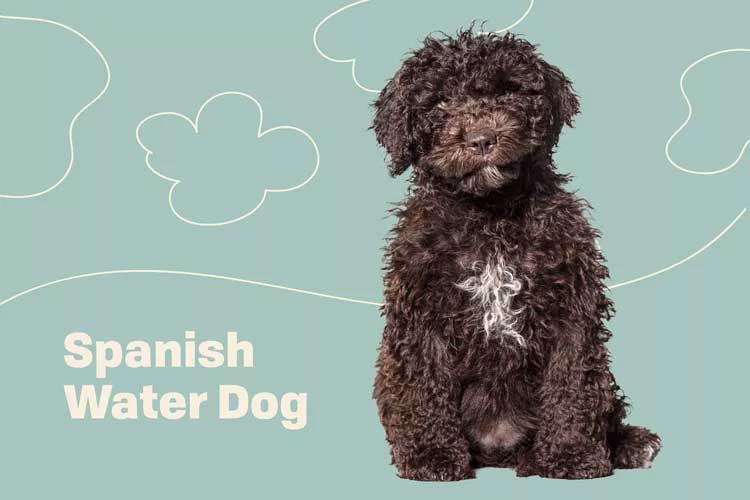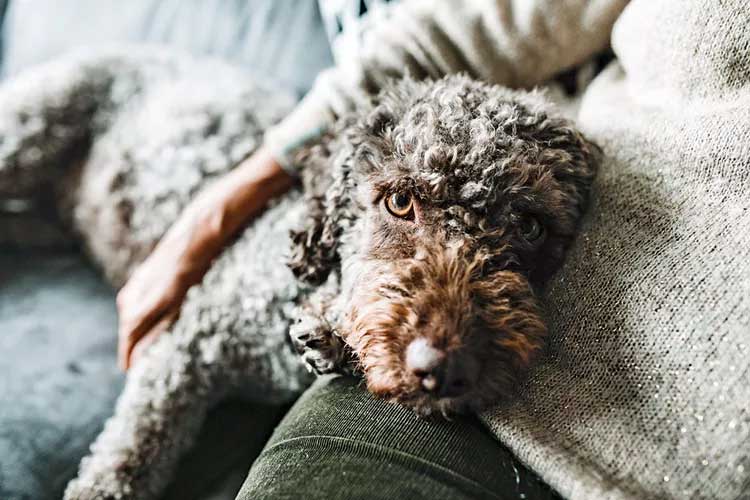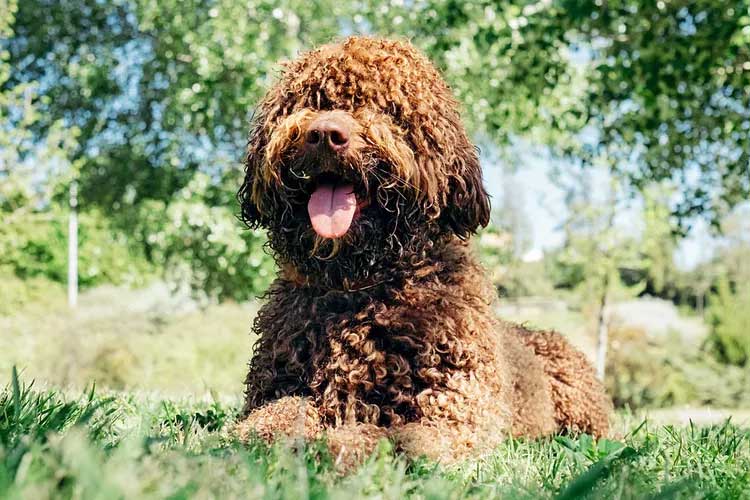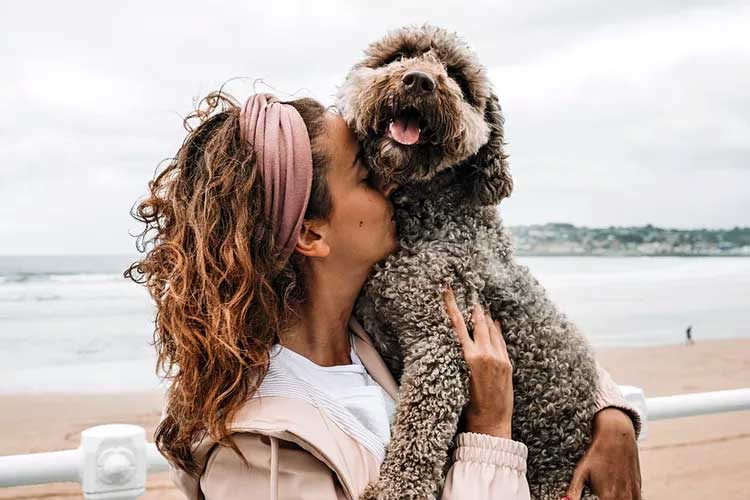
Spanish Water Dog Overview
| OFFICIAL NAME | Spanish Water Dog |
| COMMON NAME | Spanish Water Dog |
| PET HEIGHT | 15 to 19 inches |
| PET WEIGHT | 31 to 49 pounds |
| LIFESPAN | 12 to 14 years |
| GOOD WITH | children, dogs, families |
| TEMPERAMENT | outgoing, playful |
| INTELLIGENCE | high |
| SHEDDING AMOUNT | infrequent |
| EXERCISE NEEDS | high |
| ENERGY LEVEL | active |
| VOCAL LEVEL | when necessary |
| DROOL AMOUNT | low |
| BREED GROUP | herding |
| BREED SIZE | medium (26-60 lbs.) |
| COAT LENGTH | curly, medium |
| COLORS | black, brown / chocolate / liver, cream, white |
| PATTERNS | bicolor |
| OTHER TRAITS | apartment-friendly, cold weather tolerant, easy to train, good hiking companion, hypoallergenic, loves water, prone to health issues, strong loyalty tendencies |
Spanish water dogs are smart, playful, energetic, and are incredibly loyal to their families. Standing 15–20 inches at the shoulder and weighing 31–49 pounds, they thrive on human interactions and are considered to be "Velcro" dogs.
Spanish water dogs need to be active—both mentally and physically—and do very well with owners who know how to keep them engaged. Once they're fully grown, they make for ideal personal trainers, accompanying their owners in all types of strenuous activities like running, hiking, and even snow-shoeing. As their name implies, Spanish water dogs are strong swimmers, and playing fetch in the water is a terrific way to burn excess energy. But when it's time to rest and recover, don't worry, they can flip their "off switch" to Netflix and chill with you.
Keep in mind when you're out and about you may attract attention—Spanish water dogs are rare in the U.S., and you may be stopped by curious dog-lovers.
Appearance
Upon first glance, you may think that the Spanish water dog needs a good brushing, or even have her bangs trimmed so you can see her brown, expressive eyes. And while she may appear a bit unkempt, that's just how she's supposed to look!
Her distinctive naturally curly and wooly coat, which can be black, brown, beige, white, or particolor (black, brown, or beige with white) often forms tight, tapered cords and covers her eyes. Fortunately, she rarely sheds, so there's little sweeping up after her. And while there's no such thing as a completely hypoallergenic dog, a Spanish water dog's low-allergen coat means she can be a BFF for someone who typically sneezes around pups.
Standing 15–20 inches at the shoulder and weighing up to 49 pounds, Spanish water dogs are longer than they are tall, making for solid footing on the ground. Often referred to as "rustic," they are sturdy, medium-sized, and well-proportioned dogs.
Their tails are traditionally docked, though this practice is controversial. According to the American Veterinary Medical Association, docking is often done for purely cosmetic reasons and that it offers no proven health benefits.
You might mistake the Spanish water dog for a Portuguese water dog—and it's easy to see why! Both dogs have a similar body type and curly coat, but there are differences. A PWD can have curly or wavy fur that's either black, brown, or white. A SWD's coat, on the other hand, is always curly and comes in a few more colors. Spanish water dogs are also shorter and weigh about 10 pounds less than their Portuguese counterparts.
Temperament
Loving, loyal, and highly intelligent perfectly describe the Spanish water dog, and it's what makes them a terrific part of the family."Spanish water dogs bond very closely with their families; they are very loyal," says Rachel Cooper, Breed Health Coordinator with the Spanish Water Dog Club (UK) (SWDCUK).

Their smarts, responsiveness, and loyalty to their owners mean they can be a joy to train. Because they were bred for centuries to work alongside farmers and herders to keep livestock in line, the Spanish Water Dog Club of America (SWDCA) advises owners to keep these natural herding instincts in mind when training so sessions are successful for both you and your pup.
Recognizing those herding instincts is important if you have children, too, as your dog may try to round them up during playtime. Always supervise kiddos when they play with any dog and teach them how to properly interact with pets.
"As a breed, Spanish [water dogs] would not usually be recommended for small children, owing to their often strong herding and guarding instincts," Cooper says.

It's best to socialize Spanish water dogs early on so they adapt to different environments and situations, ensuring that they're as comfortable as you are. The SWDCUK suggests exposing young Spanish water dog puppies to new sounds and environments to help them become more familiar. A few to consider: Vehicle noise and traffic; children; other dogs; and sudden noises such as fireworks, thunder, and rain.
Because of their herding tendencies, Spanish water dogs may not be for everyone and are better suited to living with an experienced dog owner, says Heather Stimson, owner of Copper Kennel and an AKC Breeder with H.E.A.R.T.
"This is a wonderful breed in so many ways, but it's also a working breed that is highly intelligent, sometimes naughty, and oftentimes trying to test boundaries," Stimson says. "Ask [your breeder] questions, lots and lots of questions. Don't accept a puppy just because someone told you this was the right one for you. Ask why this one is the best fit!"
Living Needs
When it comes to living environments that are best for Spanish water dogs, Stimson says, "Some of our best-adapted dogs are those that live in inner cities; their lifestyle is non-stop hustle and bustle. They don't know anything else, therefore they are happy in the cities."However, not all Spanish will thrive in this type of environment," she continues. "I am very careful to not place more reserved or bashful dogs in cities with inactive families. That is a recipe for disaster! As long as a Spanish water dog gets consistent exercise, a huge yard is not a must, but is desired when possible."
Stimson says they can coexist well with other pets, including cats, if you introduce your Spanish water dog puppy to other animals when she's young.
"The biggest issue you would be concerned with would be your dog attempting to 'herd' other animals," she says. "That is not always well received, especially in cats."

With her smarts and ample energy, coupled with her natural herding instincts, it's no surprise a Spanish water dog is happiest when working. You may not have her out herding sheep or cattle, but you can redirect that energy into activities you can do together to further strengthen your bond, like playing fetch, hiking, swimming, boating, agility, flyball, and dock diving. At the end of an active day, she's ready to snuggle up alongside you.
Care
When it comes to grooming a Spanish water dog, a "less is more" attitude works best. That's to say, her coat should never be brushed, combed, or blown out to maintain her rustic appearance. For her baths, the SWDCA suggests using a doggie shampoo without heavy conditioners and to wash her coat like you would a sweater: Squeeze the shampoo through her coat. Once she's thoroughly rinsed, blot her coat with a towel and let her air-dry.After a few months, her coat will start forming characteristic cords, which is a good sign! But she may start matting a bit behind her ears, around her neck, and on her rear. Use your fingers to separate the mats, not a comb or brush.

Regular baths at home and attention to mats should keep your Spanish water dog clean and healthy, and she'll need to go to the groomer just two or three times a year.
As with all dogs, take the time at home to ensure your Spanish water dog's ears are clean, her nails are trimmed, and her teeth are brushed often.
Because they've been bred for centuries to work with herders and farmers to control livestock, Spanish water dogs take to training well and are responsive to their environments. Like all dogs, consistent positive reinforcement training throughout her life will help her be polite and well-behaved.
"Spanish water dogs do not respond well to 'traditional' or 'old-fashioned, fear-based' training," Cooper says. "They need to trust their humans and respond fantastically to positive reward-based training and/or clicker training."
Stimson says Spanish water dogs are slow to mature and need consistent training throughout life, not just until they're potty trained.
"This is a very intelligent breed; they need something to engage their minds," Stimson says. "They don't care what it is, but they need something to do."
Health
Spanish water dogs have a lifespan of 12–14 years, and, like all breeds, they do have a few health concerns to be aware of."The Spanish water dog is prone to hip dysplasia and allergies," says Stacy Choczynski Johnson, DVM, veterinary expert for Pumpkin Pet Insurance.
Johnson says other less-common diseases are overrepresented in this breed, including:
Hormone diseases such as hypothyroidism, hyperadrenocorticism, and hypoadrenocorticism.
Eye diseases including glaucoma and progressive retinal atrophy.
Neurological diseases such as neuroaxonal dystrophy and epilepsy.
A gastrointestinal disease called exocrine pancreatic insufficiency.
Hypothyroidism.
The Spanish water dog is prone to two types of hypothyroidism—congenital hypothyroidism with goiter and the common autoimmune thyroiditis," Johnson says. "Pet parents of adult dogs should look out for hair loss (particularly on the tail), weight gain, and lethargy."
As far as eye conditions, Johnson adds that Spanish water dogs may develop distichiasis, wherein they grow aberrant eyelashes that can rub on the eye's surface, and "cherry eye" where scroll-shaped cartilage causes the third eyelid to bulge, appearing as a red fleshy protrusion in the inner corner of the eye.
"A prolapsed third eyelid is not an emergency, but a vet visit is recommended for evaluation and surgical correction," Johnson says.
As your pup ages, consult your veterinarian if you suspect she is developing any of these conditions.
Aside from these potential conditions, your Spanish water dog should visit the vet for regular checkups and vaccinations. You'll also want to talk to your vet about flea and tick prevention, either seasonally or year-round, depending on where you live.

History
Though fairly new to the domestic lifestyle, Spanish water dogs have been found throughout the Spanish countryside for more than 800 years; according to the SWDCA, the breed was first mentioned in historical literature in 1100 A.D. The dogs were bred to work in capacities like herding, hunting, water work, protecting the home and farm, and even companionship.There are a few theories on where this breed originated, but some believe they have African origins and worked alongside North African tribes in water work and herding. As far as her arrival to Spain, there are two theories: That she arrived with settlers from North Africa or on Turkish boats between 600–900 A.D.
However she arrived in Spain, her work was dependent upon where she wound up within the country. Dogs who lived in the central and southern regions herded goats, sheep, cows, and pigs to seasonal pastures, and hunted fowl and small game. Those in the coastal regions in the north retrieved any fish or tackle that fell from boats.
Even with her long history, it was only in 1985 that the Spanish water dog was recognized by the Real Sociedad Canina de España, and a few years later the breed standard was established based upon a black and white dog named Lucky. The American Kennel Club fully recognized the Spanish water dog in 2015.
Fun Facts
A rescued Spanish water dog named Harry went on a round-the-world bicycling trip with his owner Cari, a photographer from China. The pair visited 23 countries in Central Asia, Europe, and North America between 2014 and 2015.The Spanish water dog is also known as a Perro de Agua Español, Turco Andaluz, Perro Turco, and Andalusian Turk.